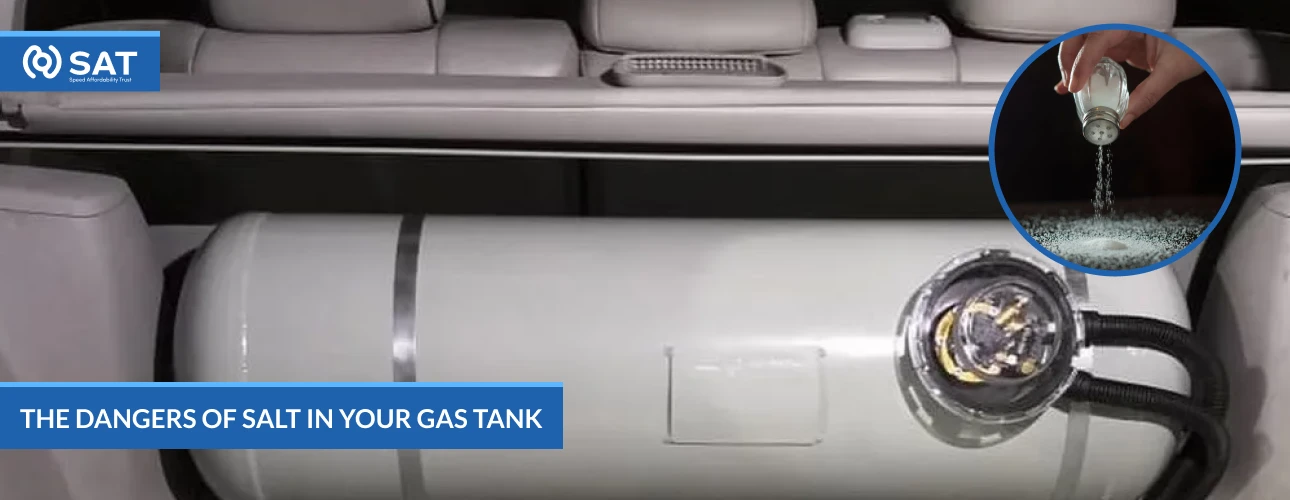Cars are complex mechanisms that work on strict principles of chemistry and mechanization. Introducing foreign elements into such a sensitive system will do much harm, and salt is the most dangerous. Although it seems unimaginable to do so, knowing the possible risks and results of putting salt in gas tank could actually be very important information for car owners. This guide will explain salt’s dangers in a gas tank, providing a person with the associated risks and the kind of damage that it can cause, whether out of curiosity or concern.
What Happens if You Put Salt in a Gas Tank?
Salt is a chemical compound—sodium chloride—which can easily dissolve in water and create a saline solution. Salt, when it gets into your gas tank, initiates terror on your vehicle’s fuel system.
Below are the things that can happen when putting salt in gas tank or fuel system :
Corrosion of Fuel System Parts:
Salt is well known for its corrosive properties. Dissolved in water, it may enhance the corrosion of metal parts in your fuel system. This includes severe rusting or corrosion in components like the gas tank, fuel lines, fuel injectors, Water Enters your Gas Tank, and even the engine. Eventually, this will cause fuel leaks, lead to clogged injectors, and destroy engine internal components.
Fuel Filter Clogging:
Salt particles, and later on the saline solution, may accumulate in this fuel filter. The fuel filter entraps all particles of dirt before they can enter the engine. However, with the addition of salt, the filter fills up quickly and chokes, thereby blocking the fuel supply to the engine. A clogged fuel filter will lead to erratic running, stalling, and might finally make the engine stop running altogether if not taken care of in time.
Fuel Contamination:
When salt is introduced to a gas tank, it dissolves in the water that might be present in the fuel. While gasoline and water do not directly mix, the inclusion of water in a fuel tank might be through the presence of condensation or just through low-quality fuel. Once the saltwater solution has been formed, it could then be sucked into the fuel system and contaminate the gas. It thereby reduces its ability to burn. The rest is a problem of loss of power and higher emissions due to inefficient combustion. For a similar destructive effect, consider How Bleach Can Destroy Your Car Engine.
Damage to Fuel Injectors:
Fuel injectors are made in a way that they need to give out a fine mist of fuel inside the engine’s combustion chambers. Salt particulates are likely to eat out such delicate components of fuel delivery, leading them to fail. This can give way to problems like inferior performance, lowered fuel productivity, and other major problems together with rather costly repairs or overhauling.
Harm to the Engine:
The most damaging result of pouring salt into a gas tank is the potential for harm caused to the engine. If the contaminated fuel makes it to the engine, this can cause internal damage through corrosion and wrong combustion. To this extent, the engine may most likely fire out of sequence, run rough, or just not start at all. In the cases like Worst Liquid to Put in Car Gas Tank, engine damage from salt is irreversible; this clearly calls for a new or total engine build.
Why Would Someone Put Salt in a Gas Tank?
Even though the idea of putting salt in a gas tank might seem far-fetched, it could happen in a few instances:
Vandalism:
A very common reason a gas tank is found with salt could be vandalism. Various harm-intending individuals can pour salt into the gas tank of the vehicle causing destruction. This kind of gross damage calls for big repair expenses for the vehicle owner, who will be disturbed by many inconveniences.
Pranks:
Sometimes, for a joke or due to a completely bizarre misunderstanding of what would happen, salt is put into a gas tank. Again, this is highly dangerous and irresponsible: the results could be major damage to the vehicle.
Following Unprofessional Myths:
There have been myths, such as using unconventional elements to repair automotive problems. For instance, some myths suggest that placing salt in a gas tank might just clean the fuel system or somehow rectify a given problem. The same is not true and will only lead to potential damage to the motor vehicle.
Prevention and Cure of Salt in a Gas Tank
Prevention:
Most importantly, the best prevention against the dangers of salt in your gas tank is to prevent vandalism by taking care and being well-protected. Always park your vehicle in a safer place—for instance, in a garage or under a very luminous location— and consider having a locking gas cap to block possible access to your fuel tank from unwanted hands.
Identification of the Symptoms:
You should recognize the symptoms in case you suspect the introduction of salt in your gas tank. These could be poor engine performance, difficulty in engine starting, reduced fuel economy, or noise from the engine. If any of the symptoms are named appear, one should act urgently.
Necessary Action:
If you believe you have had salt poured into your fuel tank, do not start the engine. Starting the engine may move contaminated fuel throughout the entire system, causing even greater damage. Instead, have your vehicle towed to an auto repair facility equipped to drain your fuel tank, clean the fuel system, and check for other damages. This is similar to the Impact of Coke on your Car Engines, where foreign substances can lead to severe engine damage.
Repairs and Cleanup:
Any salt residue in the fuel system will have to be very carefully flushed by a mechanic from the gas tank, fuel lines, and injectors. In severe cases, components such as the fuel pump, fuel injectors, or even the engine may need repair or replacement. It can be costly, but surely preventive further on in your vehicle’s security.
Stay Aware and Safe
The dangers of salt in your gas tank are uncountable. That salty-looking substance in the gas tank has the potential for wide distribution in your fuel system, all the way through the engine, costing you a lot of money in repairs and long periods of downtime. Salt in a gas tank, whether put in there through the act of vandalism, a silly prank, or a misunderstanding between the solution to another problem—either way—should not be counted. Take further preventive measures and act promptly if salt is suspected in the vehicle in order to protect it from this kind of dangerous situation and its very costly results. For expert advice on car maintenance and issues, trust SAT Japan to guide you.




